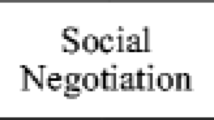Abstract
This study was designed to address two purposes. First, we wanted to test working hypotheses derived from previous studies about the transformation of individual and collective knowledge in elementary classrooms. Second, we attempted to understand the degree to which “ownership” was an appropriate concept to understand the process of learning in science classrooms. Over a four-month period, we collected extensive data in a Grade 6/7 classroom studying simple machines. As in our previous studies we found that (a) conceptual and material resources were readily shared among students, and (b) tool-related practices were appropriated as newcomers participated with more competent others (peers and teachers) in the pursuit of student-framed goals. We also found that for discursive change (“learning”) at the classroom level to occur, it appeared more important whether a new language game was closely related to students' previous language games than who actually proposed the new language game (teacher or student). Implications are drawn for the design of science curricula and classroom activities.
Both pedagogy and design are still tightly bound by rationalist, symbol-manipulating, problem-solving assumptions that hold knowledge to be a property of individuals. Pedagogy still concentrates on the individual and individual performance, even though most work is ultimately collaborative and highly social. (Brown & Duguid, 1992, p. 171)
Similar content being viewed by others
References
Bakhtin, M. (1981).The dialogic imagination. Austin: University of Texas.
Brown, A. L. (1992). Design experiments: Theoretical and methodological challenges in creating complex interventions in classroom settings.The Journal of the Learning Sciences, 2, 141–178.
Brown, J. S., & Duguid, P. (1992). Enacting design for the workplace. In P. S. Adler & T. A. Winograd (Eds.),Usability: Turning technologies into tools (pp. 164–197) New York: Oxford University Press.
Cobb, P., Wood, T., Yackel, E., Nicholls, J., Wheatley, G., Trigatti, B., & Perlwitz, M. (1991). Problem-centred mathematics projects.Journal of Research in Mathematics Education, 22, 3–29.
Ehn, P., & Kyng, M. (1991). Cardboard computers: Mocking-it-up or hands-on the future. In J. Greenbaum & M. Kyng (Eds.),Design at work: Cooperative design of computer systems (pp. 169–195). Hillsdale, NJ: LEA.
German, P. J. (1994). Testing a model of science process skills acquisition: An interaction with parents' education, preferred language, gender, science attitude, cognitive development, academic ability, and biology knowledge,Journal of Research in Science Teaching, 31, 749–783.
Gooding, D. (1992). Putting agency back into experiment. In A. Pickering (Ed.),Science as practice and culture (pp. 65–112). Chicago, IL: The University of Chicago Press.
Guba, E., & Lincoln, Y. (1989). Fourth generation evaluation. Beverly Hills, CA: Sage.
Harel, I. (1991).Children designers: Interdisciplinary constructions for learning and knowing mathematics in a computer-rich school. Norwood, NJ: Ablex.
Hatano, G., & Inagaki, K. (1987). A theory of motivation for comprehension and its application to mathematics instruction. In T. A. Romberg & D. M. Steward (Eds.),The monitoring of school mathematics: Background papers (Vol. 2). Implications from psychology, outcomes of instruction (pp. 27–66). Madison: Wisconsin Center for Educational Research.
Jordan, B., & Henderson, A. (1995). Interaction analysis: Foundations and practice.The Journal of the Learning Sciences, 4, 39–103.
Kafai, Y. B. (1994)Minds in play: Computer game design as a context for children's learning. Hillsdale, NJ: Lawrence Erlbaum Associates.
Lampert, M. (1986). Knowing, doing, and teaching multiplication.Cognition and Instruction, 3, 305–342.
Latour, B. (1987).Science in action: How to follow scientists and engineers through society. Milton Keynes: Open University Press.
Lave, J., & Wenger, E. (1991).Situated learning: Legitimate peripheral participation. Cambridge: Cambridge University Press.
Lincoln, Y. S., & Guba, E. (1985).Naturalistic inquiry. Beverly Hills, CA: Sage.
Rorty, R. (1989).Contingency, irony, and solidarity Cambridge: Cambridge University Press.
Roth, W. M. (1991). The development of reasoning on the balance beam.Journal of Research in Science Teaching, 28, 631–645.
Roth, W. M. (1995a). Affordances of computers in teacher-student interactions: The case of Interactive Physics.Journal of Research in Science Teaching, 32, 329–347.
Roth, W. M. (1995b). The vo-evolution of situated language and physics knowing.The Journal of the Learning Sciences, 4.
Roth, W. M. (in press-a). Art and artefact of children's designing: A situated cognition perspective.The Journal of the Learning Sciences.
Roth, W. M. (in press-b). Inventors, copycats, and everyone else: The emergence of shared (arti)facts and concepts as defining aspects of classroom communities.Science Education.
Roth, W. M. (in press-c). Knowledge diffusion in a Grade 4/5 classroom during a unit on civil engineering: An analysis of a classroom community in terms of its changing resources and practices.Cognition and Instruction.
Roth, W. M., & Bowen, G. M. (1995). Knowing and interacting: A study of culture, practices, and resources in a Grade 8 open-inquiry science classroom guided by a cognitive apprenticeship metaphor.Cognition and Instruction, 13, 73–128.
Roth, W. M., & Roychoudhury, A. (1992). The social construction of scientific concepts or the concept map as conscription device and tool for social thinking in high school science.Science Education, 76, 531–557.
Schauble, L., Glaser, R., Duschl, R. A., Schulze, S., & John, J. (1995). Students' understanding of the objectives and procedures of experimentation in the science classroom.The Journal of the Learning Sciences, 4, 131–166.
Suchman, L. A., & Trigg, R. H. (1991). Understanding practice: Video as a medium for reflection and design. In J. Greenbaum & M. Kyng (Eds.),Design at work: Cooperative design of computer systems (pp. 65–89). Hillsdale, NJ: LEA.
Winograd, T., & Flores, F. (1987).Understanding computers and cognition: A new foundation for design. Norwood, NJ: Ablex.
Author information
Authors and Affiliations
Corresponding author
Rights and permissions
About this article
Cite this article
McGinn, M.K., Roth, WM., Boutonné, S. et al. The transformation of individual and collective knowledge in elementary science classrooms that are organised as knowledge-building communities. Research in Science Education 25, 163–189 (1995). https://doi.org/10.1007/BF02356450
Issue Date:
DOI: https://doi.org/10.1007/BF02356450




